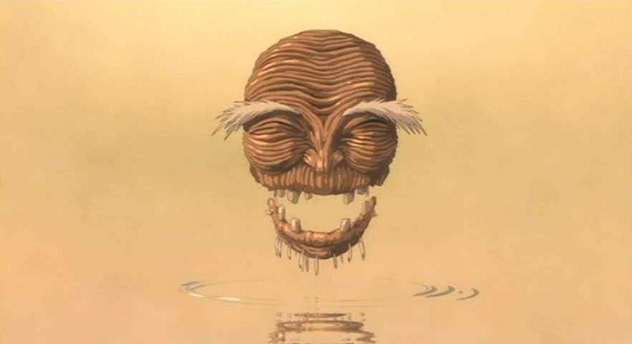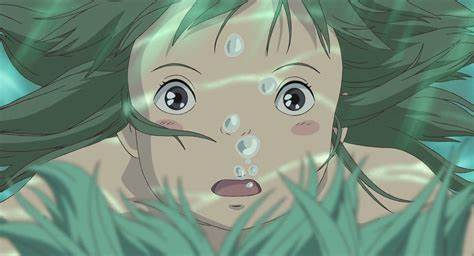Hidden Journey and Symbols of Spirited Away
- victoriaxc
- Feb 8, 2020
- 7 min read
Updated: May 4, 2020

Spirited Away has been a classic animated film that is very much respected as a piece of art. When looking at the big picture of the film, it is easy to see Chihiro’s growth from being a scared little girl during her ride with her parents to a mature and independent girl who takes her own path and journey while saving her parents from slaughter. From Chihiro's journey throughout the film, the audience is able to see her grow and mature as she works hard to transform her parents back to humans from the pig pen. Simply looking at the surface of the film Spirited Away, it is easy to see that this animated film incorporates many different fictional ideas. However, by examining the story and the ideas of the film, there are actually many different symbols and hidden meanings behind the diverse characters and storyline. On the subjective side, Spirited Away may seem like a fascinating animated film with spectacular animation that incorporates both traditional as well as digital animation. But there are many different themes that can easily be overlooked such as the critique of consumerism being portrayed in the film or contrasting to that, the heroic quest to maturity and growth of a young girl.

With the fascinating storyline displaying the adventures of Chihiro, it is easy to overlook Hayao Miyazaki’s critique of consumerism. One main event in the film that easily displays Miyazaki’s critique of human consumerism is through the scene of the Stink god from the bath house run by Yubaba. In this scene, the Stink god comes to the bath house as a customer who appears to be a spirit so dirty that its physical appearance is that of an enormous reeking dump of garbage and ooze.
The Stink god’s body was composed of many consumer items as well as disposed garbage bags and rusted metal materials. With just the visual display of this customer going in the bath house, the audience is able to smell and feel the disgusting essense that the Stink god gives off. The pile of garbage that the Stink god is composed of overflows the bathhouse. Wherever he passes by a huge dump of mud and garbage is left in its place. However, the audience later comes to realize that this customer was actually the beautiful spirit of the river.
With this character incorporated in this film, one could easily miss the meaning of this character as they are mesmerized by the storyline and shock of the event. However, when taking a closer look at this character, the Stink god actually represents the spirit of the river that has been so polluted that it is overflowing with garbage and has become unidentifiable. With all the garbage, used metal and trash coming out of the Stink god, it is impossible to tell that it was actually the beautiful spirit of the river. This shows how humans pollute the environment through the disposal of waste materials in the river. The fast consummation of material items is polluting Mother Nature making it unidentifiable and shrouding its real beauty.
Stuck in the Stink god was many garbage bags as well as used bikes and furniture. All these pollution dumped in the river completely cover the natural beauty of the river and therefore need to be removed in order to reveal its true beauty again. This is the real hidden meaning behind this character. Miyazaki skillfully incorporates this into the film to critique the situation of human consumerism. It is only after the Stink god went through several baths that it was able to show its true hidden and beautiful self. It was only through this process of washing, healing, and the removing of all the waste and garbage from the body of the Stink god that the people were able to see this customer’s real hidden beauty.

With this theme showing the waste that covers the beauty of the land, Miyazaki also shows the beauty of the land through many different scenes. One example would be the scene when Chihiro stands at the train tracks waiting for the train so she could travel to Zeniba. This scene shows the railroad under the water as well as the beauty of the pure and clean water all across the land. The water combined with the railroad shows the beauty of clean water as well as the calmness of the pure land. This combination of the railroad also displays the journey to the eternal realm.
The Japanese culture often believed in another realm, therefore the scene with the water joining with the railroad symbolizes a journey across the sea to a pure land. This interesting juxtaposition of the train linked to the land merging with water are the two different realms overlapping. This is easily overlooked and is quite paradoxical, but it is an interesting way to join the two worlds. This scene is a contrasting picture to the Stink god, a river spirit polluted by humans, that is compared to a natural and pure water railroad leading to a clean and clear pure land across the sea. This contrasting comparison shows human consumerism as an environmental fable. It shows how industrialization and human consumerism has ruined and covered the pure and beautiful land we live on.

The bath house is also very significant as it shows the hierarchy of civilization as well as the Japanese culture. The bath house is ruled by Yubaba, where she represents the apex of the hierarchy. She is the one that rules and overlooks the whole bath house. Whereas Kamaji, the man living underneath all the production, represents the bottom of the hierarchy where all the industrial labor takes place for the bath house to function. Kamaji is also known as the “spider man” where his name could be translated to “earth spider” depending on the chinese characters used. His character represents the industrial laborers, people who labor hard but in a subterrestrial way.
Although often overlooked, Kamaji is a crucial character because his work is what keeps the bath house running. But the environment that he works in and his character also gives off the dark and dirty view of manual and industrial labor. From the environment displayed through the animation, the dark industrial view is brought out through the underground work of Kamaji. Focusing on the two characters, Yubaba and Kamaji, Miyazaki clearly depicts the hierarchy of society as well as the culture of Japan.
When zooming out to look at the big picture of Spirited Away, if one were to focus on the character of Chihiro, one evident theme is the individual growth of a girl and her heroic quest. From the introduction of the film, Chihiro is portrayed as an immature little girl who is unhappy with her situation of having to move to another town. She gives attitude to her parents seen through her body language in the car as she gazes off in the distance with a look of dissatisfaction. However, as she journeys throughout the story, she is faced with many obstacles which she had to overcome in order to turn her parents back from pigs to human beings and return to her normal life. Through her journey, the audience is able to feel her growth in maturity as she works through sweat and tears to save her parents. Chihiro’s endurance and effort allowed her to conquer her quest and was what made her become the girl she turned out to be. She becomes more independent and is able to achieve success through her perseverance and hard work.

During Chihiro’s journey through the film, she also makes many friends and acquaintances who helped her save her parents from the pig den. Her interactions with her friends show her growth process as she gains knowledge and experience through the help of her friends. These all may seem very miniscule compared to the big picture of the film, however, they are what add feelings to the film. Through Chihiro’s interaction with her friends and her reaction to her surrounding situations, we see how she slowly changes from the whiny little girl to the pure-hearted lady who treats others with love and care.
From the beginning of the film, she is a child who is unhappy with her own situation, however through her labor working at the bath house, she learns to be someone who is considerate and aware of the people around her. She learns that there is so much more than her own situations that she needs to resolve, others all have their own story and problems they have to overcome. She learns to care for others and becomes aware of others’ situations. She learns the story of Haku and takes care of him and realizes that although the situation is hard for herself, her friends and others are also going through tough situations. Through such realizations, she matures and turns from the child who used to whine and complain in the beginning of the film to someone who sympathizes with her friends’ situations and helps them to the best of her ability.
Through the Analysis of Miyazaki's Spirited Away, it is evident that if one looks more thoroughly into these animated tales, one may be able to find deeper meanings and the incorporation of symbolic ideas intertwined with the storyline. Miyazaki crafts the film to be interpreted as a critique of consumerism showing the effects of human pollution to nature. The progression of the film also shows the growth of Chihiro through her heroic quest to save her parents and become a more mature and independent girl. Each character displays meaningful significance and represents a greater idea than the character itself as depicted through the analysis of Yubaba and Kamaji. Each event is also connected to much more than just the storyline of the film; they reflect the real world as well as cultural situations.
Spirited Away captures not only the audience's heart and love but also allows the audience to realize the world around them, such as how industrialization is affecting the environment. Miyazaki skillfully comments on the consumerism of humans and the effects of it through the characters emotions, actions, as well as the events of the film. Spirited Away has a fascinating storyline yet is an eye opener to the world if the audience is able to look behind the characters and the events to find the hidden meanings in the animation. Not only is this film an entertainment to many, but it also displays intellectual and cultural significance. It is clearly a masterpiece in the animation and film industry.




Comments